#goat much like her other mother is transgender
Text

The top two characters will be eligible to proceed into the bracket!
Propaganda under the cut.
Elagabalus:
Elagabalus was a Roman Emperor, a priest, a prostitute, and probably transgender. Which is a great combination of things to be. She had so much sex everyone hated her for it. She "abandoned [her]self to the grossest pleasures with uncovered fury" and "the name Elagabalus is branded in history above all others" because of her "unspeakably disgusting life"
Anne Boleyn:
Broke England from the Papacy, her sister was the ORIGINAL throat goat, she was a badass mother fucker and unfortunately did have sex with Henry VIII
https://open.spotify.com/episode/55OrGEVUOl5GPNpTlFgEMW?si=PtdjG3AWSjKOqiJQqR1iOg
The submitter was also VERY adamant that they were NOT referring to the version of Queen Anne Boleyn depicted in SIX.
Wu Xetian:
Did so many murders but was also a really good ruler so like. Ends… could? Justify means?
33 notes
·
View notes
Text
alright alright, do yall want my dreamSMP headcanons?? keep in mind that i only watch a few of them
/dsmp
Possible TW's: trauma, manipulation, death, suicide, overdose; the basic dreamSMP stuff, unfortunately.
ok here we go:
Dream - a separate entity from DreamXD, though they are related; perhaps XD is from another universe? anyways, Dream was possessed by a 'Dreamon' at a young age, making him think that things like manipulation are ok simply because he didn't know any better. he says he's trying to get better, but is he? no. this is just another trick to make Tommy think he can change. Jacob Sheep horns are slowly growing (sheep-hybrid thanks to his mother, Cpt. Puffy). Him becoming family with George and Sapnap made him realize that he can make his own family, an idea which he twisted and turned into manipulation. In his words, paraphrased, he "did a bad thing but for good reasons" which were "bringing the server together"; he wanted to be a family with him in control, a dictatorship, a hivemind.
Drista - Dream's sister, more related to XD than Dream is. somewhat OP but has morals unlike her brother.
George - Mooshroom hybrid!! Has a little mushroom crown and cape because he thinks of himself as royalty (he isn't) - has little horns and a little tail. Misses Dream the most out of the Dream Team, but somewhat afraid of him. Wants 'the old dream' back, which was partly a persona and partly Dream learning about found family. He tries not to get involved with politics or the server after the events of the first wars, because he's scared. Sleeps through things as an excuse. Awesamdude's kid - doesn't tell anyone.
Sapnap - Dragon hybrid - has small horns and a tail, with burn marks at the base of them. His hands and feet are clawed and burnt. He also wants their Dream back, but understands that he was always corrupt and has mostly gotten over it. Wants to help with the Egg but, like George, doesn't like getting involved with big things on the server. He's ashamed of his dragon heritage, covering up his head burns with a headband and covering his horns with his hair; he hides his tail under a cape and wears gloves as well. Sapnap has unnaturally orange eyes, which he would change with contacts, if they didn't melt anytime he tried. Battle-scarred and hungry to start fights and sever friendships out of boredom. Badboyhalo's child.
Callahan - Cervitaur (deer-centaur). Distantly related to Puffy, Captain Sparklez, and Schlatt. I will admit, I have never watched him, and I don't think he's ever been too involved in server politics? Just a simple deer man trying to live his life.
Awesamdude - Creeper centaur thing (he and Callahan are... cousins? i guess?). Incredibly insecure about his morality and the fact that George doesn't talk to him much. Thinks he's a bad person. He becomes a father figure to Tommy through his Sam Nook persona - slowly gaining his confidence back through his real estate and his (illegal) adoption of the gremlin. Badass. Runs the prison by himself because he feels the need to prove himself, and he doesn't know anyone that would be up to the job.
Alyssa - inactive :[ probably human
Ponk - Human!! One of the few humans on this server, actually! He quite likes building and terraforming; he makes very aesthetic builds (see; war campsite). He and Sam are close friends. Ponk is also a parental figure to Tommy, but is closer to the fun uncle. The three of them steal together and then Ponk and Sam cover for Tommy because who could accuse them of lying?? Hesitant to join in with politics.
BadBoyHalo - Demon. Very, very tall demon. Large. Pretty wholesome. I honestly don't know what else to say about him lmao I haven't been paying attention to the Egg much. He and Skeppy are a thing though. Wishes his son would stop killing people's pets to start wars.
TommyInnit - He doesn't know what kind of hybrid he his, but he isn't human. His eyes change color with mood, going from a light grey to an extremely vibrant cobalt blue. He believes he may be part raccoon, or part bird(?) on Philza's side. Phil wasn't around during his childhood; Tommy only knew him as the hero from the strories that his older brother Wilbur told him. Philza killing Villain!Bur cemented his heroship, which is why Tommy sees him as a father figure. Wilbur never told him that he (Phil) was their father. Tommy is actually part siren, but his gills and fins haven't appeared yet. His PTSD is triggered by Dream, blackstone, tnt, people asking for his armor, and a few other things. An extremely traumatized kid. Best friends with Tubbo.
Tubbo - Sheep hybrid. His horns started coming in during Schlatt's presidentship, making him think he was a goat and following in his footsteps. In reality, he's Captain Sparklez's son; related to Schlatt yes, but not at all like him. He likes headbutting the people he loves, including his best friend Tommy. Wholesome, but still a chaotic being of destruction. He and Ranboo are also very good friends!
Fundy - Fox shifter; unlike most of the other hybrids on this server (other than Techno), he can turn into an anthro fox. Canonically transgender! Son to WilburSoot and Sally the Salmon (another shifter). Wilbur was an amazing father while Fundy was small, but started neglecting him during the Presidency, when he really needed a father. The two grew apart further during Pogtopia, and Fundy still tries to refuse his father's attempts at redemption. Despite this, Fundy and Ghostbur, even though they've had arguments, have a better relationship. Fundy is even one of the people who are attempting to bring back Wilbur. He sees Phil as a somewhat father figure despite him trying to be bitter towards him. Very involved with L'manburg and DreamSMP poilitics, but has taken a step back since his dad's death. Fundy also canonically misses Schlatt and wants him to be proud of him. He picked up smoking from him.
Punz - gonna be honest, I have never watched Punz.
Purpled - Enderdragon hybrid. Like Sapnap, but purple lol. Use to have a healthy rivalry with Technoblade, but doesn't talk to him anymore. A bit reserved. I don't watch him either idk if you could tell.
Wilbur - Bird hybrid, like Philza; his wings were clipped by Dream when he first began fighting for independence. Good friends with Technoblade. Wilbur was an idealistic person, and he was probably the most loyal member of L'manburg. He was so upset about the betrayals, he thought of them not as betrayals to the country, but to himself. When Schlatt took over, he began to panic. His perfect nation was being ruined, his nation, HIS nation. He thought of it as his and his alone; all those other people? They were side characters. L'manburg his unfinished symphony wasn't his anymore. It scared him. He began planning to take the country out because, well, if he can't have him, then no one can. He manipulated Tommy, making him go along with his plan, slowly becoming more insane and destructive. Deep down, Wil still loved his family, and his country, and his lost lover, but that didn't matter to him anymore. After blowing up L'manburg (the first explosion), Wilbur broke down. He realized what he had done, he'd become a bad guy; he'd worked with Dream. He asked his father to kill him. And so Philza did.
Ghostbur - Wings work again. Ghostbur pretends not to remember, he pretends that he's changed in death, but he remembers all of it. The bad memories hurt him now, more than ever, and he just can't deal with it; so he doesn't. Water makes him melt, and that includes tears. He's trying so hard to be a good person, he's trying so hard to be a good father, a good brother, a good friend. But it isn't working. He's still, though unintentionally, hurting people, and he feels so bad about it.
Schlatt - Ram hybrid. Brother to Puffy and Jordan (Sparklez). Schlatt is a smoker and an alcoholic, and a power hungry dictator. Or well, that's the persona he puts on. Schlatt, in reality (still /dsmp) genuinely does not give a fuck. He didn't care what happened, because he knew that people disliked him. He knew for a fact that he would be killed. This is why I believe he offed himself. He planned his stroke, or heart attack, the fandom doesn't seem to know which. He probably ingested some bad protein powder or poison or something, maybe he drank himself to death, maybe he OD'd and then drank, we don't know. But it seems unlikely that someone like him would let his body give out like that without a reason. Oh yeah, and he and Quackity were married at some point, but it was too short to really mean anything.
Ghlatt - Ghlatt, though still addicted to alcohol and various drugs, feels bad about being a bad person in his life. He thinks that it's a good thing he died, that the server benefited from his death, and that he shouldn't have become a ghost. He's right, of course, but I like to think that he's regained morality. Maybe now, in the afterlife, he can work on himself. Ghlatt isn't strong enough to take a physical form, so he borrows Ghostbur's occasionally.
Skeppy - Some sort of Diamond Ore man?? I think he's human. He and BBH have a thing. I don't think I've ever watched a Skeppy DreamSMP stream. Uhh Egg?? Egg. Badlands boys woo.
Eret - Herobrine is his cousin. Like. Yeah. That Herobrine. Anyways, they're a king, and they're more of an Awesomedude morally grey type character. Her only interest is survival, and I respect that. I haven't really paid much attention to him though. Their crown has bi flag colored gems on it :]
Jack Manifold - Jack Manifol! Jack Manifall~~ Jack Manifall.. off bridge!! Jack Manidrown :} OH SHIT- (i dont watch him)
Niki - Human. Wears Wilbur's old coat. Though she did go through a tough spot after Wilbur's death, she now runs a flower shop with Puffy. Dyes her hair often. I don't watch her either.
Quackity - Duck hybrid; wings were clipped upon his joining the server. His face scar was canonized :] Alex genuinely liked Schlatt, but realized he was being mistreated so he joined Pogtopia. He felt bad about it though. I don't have many headcanons for him to be honest.
Mexican Dream - ok am i the only one that wasn't into this arc?? i didn't even watch any of it. i saw him like once and was like "oh this is just a bit" and left wtf. was he important???
Karl Jacobs - Time Traveler man; human. Karl is slowly losing his memory due to his travel between timelines. The more he does it, the more he loses. I look forward to seeing this progress. Are he, Sapnap, and uhhh someone else actually engaged?? I like that headcanons :] I don't remember who the other person is though.
HBomb - Cat maid.
Technoblade - Piglin shifter. Techno is softer than he seems, and he genuinely enjoys the company of Ranboo and his friend Philza. Technoblade met Phil after saving him from wither skeletons in the Nether, making short visits to the Overworld until he built up an immunity. He likes the cold because it's the opposite of his terrible home dimension. Techno really did want to help Tommy, but their ideals clashed too much for it to work out. Very destructive anarchist. Though, he is pretty chill nowadays.
Antfrost - Cat shifter. So I lied, there are three. Uhh wizard!! I like that HC!! Wizard catboy go brrrr. In reality, I don't watch the Badland Boys often and I haven't seen any of the Egg plot so idk what's up with him lol. I like to think that before the Egg, he and Fundy were friends.
Philza - Wings were beat up during the explosion; he tried to protect Wilbur with them, but still ended up failing. He's the father to Wilbur and Tommy, with Techno being an old friend of his. He canonically really likes cobblestone. Phil tries his best to be the dad, but his morals are all over the place. Lately, he's unofficially adopted Ranboo, helping him with his uh. Issues.
Connor - Human in a Sonic onesie idk i dont watch him
Puffy - Sheep Hybrid. Sister to Schlatt and Jordan, mother to Dream. I really don't know tbh; she's everyone's adoptive mom. She's what Philza and Awesamdude wish they could be.
Vikkstar - Human. Has he?? Done anything?? Ever??
Lazarbeam - Isn't he a gingerbread man or something.
Ranboo - Half Enderman Half [REDACTED]. I dont have headcanons for him tbh I just accept his canon. May be related to XD?
Foolish Gamers - A literal god. He can revive people, but it takes one of his lives. Uhhh he's really good at building what.
Hannahxxrose - I don't watch her :[ I should though
Slimecicle - CHARLIE SLIMECICLE. Slime hybrid obviously. New to the server, very scared [/j] and confused. Doesn't know what's going on and that's ok because he's funny I like him
I got really tired of this towards the end oops
#/dsmp#/rp#tw#tw death#tw manipulation#tw suicide#tw overdose#dreamsmp#dream smp#headcanons#head canon#dream#dreamxd#drista#georgenotfound#sapnap#callahan#awesamdude#alyssa#ponk#dropsbyponk#badboyhalo#bbh#tommyinnit#tubbo#fundy#punz#purpled#wilbursoot#beet's rambles
41 notes
·
View notes
Text
youtube
Watch the American Climate Leadership Awards 2024 now: https://youtu.be/bWiW4Rp8vF0?feature=shared
The American Climate Leadership Awards 2024 broadcast recording is now available on ecoAmerica's YouTube channel for viewers to be inspired by active climate leaders. Watch to find out which finalist received the $50,000 grand prize! Hosted by Vanessa Hauc and featuring Bill McKibben and Katharine Hayhoe!
#ACLA24#ACLA24Leaders#youtube#youtube video#climate leaders#climate solutions#climate action#climate and environment#climate#climate change#climate and health#climate blog#climate justice#climate news#weather and climate#environmental news#environment#environmental awareness#environment and health#environmental#environmental issues#environmental justice#environment protection#environmental health#Youtube
6K notes
·
View notes
Text
This Is Home - Nonbinary Iskall
AO3: https://archiveofourown.org/works/25972159
*Laughs in agender* it’s projection time
Iskall stares into the mirror, trying to work out what’s wrong. He doesn’t understand it. Something feels wrong, and he can’t work it out. Tears well up in his eyes, threatening to fall out even as he tries to blink them away.
His hair hits his shoulders now.
Everyone says it looks nice, Stress will braid it absentmindedly if he sits down in hermit meetings, no one pokes fun at his hair. No one pokes fun at him, most of the hermits even saying that he looks really nice with it. Iskall runs his hands through it, wondering why it feels so wrong , so unnatural . He thought he liked it!
Maybe it’s too short.
---
"Your hair is looking nice today my dude!" Ren says from the doorway of The Omega Store, watching as Iskall restocks. Something eats away at Iskall's stomach, confusing him. The same thing that makes him feel bad looking in a mirror is here .
"Thank you!" Iskall tries to smile, trying to ignore the chaotic dread growing in his gut.
"You should grow it longer, it suits you!" Ren pats Iskall on the back. "Be the first man in hermitcraft with middle of the back long hair!"
Man . That's not right. Why is that not right?
---
Iskall stares at the computer screen, reading over the words. Transgender. Euphoria. Dysphoria. The words wash over Iskall. The words make sense, the words fit him - her? - situation.
She.
Iskall will try she .
---
Iskall lets her hair grow out, subtly asking Stress for help. She came out to Stress soon after, when Stress offered to cut her hair.
Stress was lovely, accepting her. So was Grian, and Mumbo. Scar too, jokingly saying that Iskall started in the body Scar should have started in.
She doesn't tell anyone else, and the jungle hermits keep their lips locked.
---
Iskall stares in the mirror, wondering why she still has dysphoria, why isn't it stopping? She thought she had it figured out.
She collapses to the floor, tears jerking out of her eyes. It isn't fair.
---
“Your hair looks nice today.” Cub says, sitting next to Iskall as the hermits slowly show up for the weekly meeting. “It’s getting pretty long, since you can put it into a bun.”
“Yeah.” Iskall looks towards the middle of the room, panic in her brain. She isn’t a girl. She isn't a boy. None of this makes sense .
Stress thinks she should come out at the meeting today.
She can’t. She cant come out, not when she doesn’t know who she is. Not when none of this makes sense . Stress sends her a thumbs up from across the room, and fear settles in her heart, digging and clawing its way into her veins. This isn’t right .
Iskall can’t hear Xisuma speak. Her - no, her isn’t right. Why aren't any of them right? They is nice, but no one will respect that. He, she, those are singular. The hermits would -
“Iskall, you wanted to say something?” Xisuma says quietly, and Iskall’s head snaps up. Everyone is looking at them, and they can’t speak, they can’t think , it hurts . None of the hermits have any eyes, it’s too bright theres too many colours here. They stand, nervousness eating at their throat.
And they run.
They can’t think, it hurts too much. There’s too much here. They can’t think , it’s too much. They run, then they fall off something and they fly. They can’t even tell what dimension they’re in, everything merges together and they can hardly see let alone think about where they are.
They crash land into the side of something, curling up into a ball where they land. It hurts . It hurts, their entire side blooming in pain. They never should have gone to the meeting, they never should have told anyone that they thought they were a girl. They aren’t a girl! They aren’t a boy! They just are .
---
They sit in Doc’s bathroom, a pair of scissors in their hands. Doc found them, shivering and bruised, on top of the Goat Mother after they flew off. Doc didn’t ask anything, didn’t judge them as they were brought into his half of the mansion, just letting them rest and heal. They stared at the ceiling of the room, tears in their eyes. They don’t want to fall asleep, not yet.
Doc didn’t ask why they left. Doc didn’t judge, just handing them a pair of scissors when they asked for them.
They bring the scissors to their hair, taking a deep breath in. They start cutting, tearing unevenly through their hair as they struggle to reach the back of their head. They don’t stop, not until the tears block their vision and their hand shakes too much to continue. They collapse to the floor, holding onto the sink as they try to stop crying.
Doc runs in, shock on his face as he sees Iskall kneeling on the floor, sobbing into the side of the sink. Doc helps Iskall up, helping them to a seat outside the bathroom.
“Is it your side?” Doc asks quietly, kneeling by their side.
“I’m not a boy.” Iskall blurts out, tears in their eyes. “I’m not a girl either, I can’t keep pretending , Doc.”
“Okay.” Doc says, smiling at them. “That’s, that’s amazing. They/them?”
“ Yes .” Iskall sobs, pulling Doc into a hug. “Thank you.”
“Does Stre- Anyone else know?”
“No.”
“That’s alright. You don’t have to tell them if you aren’t ready.”
---
Iskall stayed with Doc for a few days, ignoring the hermits and building small redstone circuits under Doc’s back garden. They don’t speak that much, getting used to their pronouns. To hear them said. It’s nice. They don’t want to leave. It’s safe, working under the garden as Doc plants bushes and flowers.
“The others are worried about you.” Doc calls down into the hole that Iskall is sitting in, trying to invent a better redstone circuit. “You need to tell them that you’re okay, even if it’s just in the group chat. I think they might raid if you don’t.”
They don’t want to. They don’t want to see the rejection in the others eyes. They haven’t even worked out what they are, though Doc suggested ‘Nonbinary’ and ‘Agender’. The first one fits like an oversized sweater, comforting and large. The second one fits better, though Iskall doesn’t know if they’ll use it. The agender flag is nice though.
“You don’t have to, I could send a picture to the group chat, but I think Xisuma will come around anyways.” Doc slides down the ladder, walking over to them. “You don’t have to do anything you don’t want to.”
“You sound like a Dad.”
“I’ll call you kid later,” Doc smirks, messing with Iskall’s hair, “or kiddo.”
---
Iskall hides behind a wall, trying to ignore the fear in their chest as Xisuma, Stress, Grian and Mumbo talk to Doc. They can’t breathe, not as the small group exchanges pleasantries and small talk, clearly waiting for them. They can hear someone tap their foot impatiently, either Grian or Stress, and they try to stand, to leave the wall and face the facts.
“Is sh- Is Iskall alright?” Stress’ voice is harsh, and Iskall can’t help but to flinch away. “You said that Iskall was alright, why isn’t sh-”
“I said that they’re fine.” Doc interrupts her, and Iskall can hear the eye roll. “You petrified Iskall, no wonder they’re having trouble coming out here. You can’t force someone out, Stress.”
“What?” Xisuma says, and Iskall ducks their head around the door. Xisuma is looking at Stress, who has her hands in the air. Doc has his back to the door, though he’s clearly looking at Grian. Mumbo makes eye contact with Iskall, sending them a little wave and a questioning look.
“Doc, may I use your restroom for a second?” Mumbo asks politely, a smile under his mustache.
“Go ahead.” Doc waves off the tall redstoner, who dips behind the door, offering a hand to Iskall.
“You alright?” Mumbo mumbles.
“I’m scared.”
“Don’t be. We all love you, ‘Skall. You don’t have to be afraid.”
“I don’t think I’m a girl or a boy, Mumbo.”
“Then you’re just Iskall, unless that's not the name you want. You are you. We won’t stop supporting you because of something as simple as that .”
---
“You’re looking nice today my friend!” Ren says as Iskall restocks the Omega Store. “I like the little braids in your hair, did you do them or someone else?”
“I did them, it makes me feel nice.” Iskall smiles, a warm feeling in their chest.
Why did they think the hermits wouldn’t accept them?
They’re family.
31 notes
·
View notes
Text
So I’ve been meaning to post more images of my OCs, as I’ve made them in The Sims 4. So under the cut here is exactly that, sans the majority of my vampire OCs and a couple of others that I don’t write about or RP that often. Their names and a little info about them are above their pictures. :3
Myarel, aka my first ever OC. My grouchy demon boy. Has 5 siblings and a ton of cousins. His adoptive parent is his wife’s grandmother, Rowan. Externally grumpy, internally sweet. He and his siblings are Shadow demons.
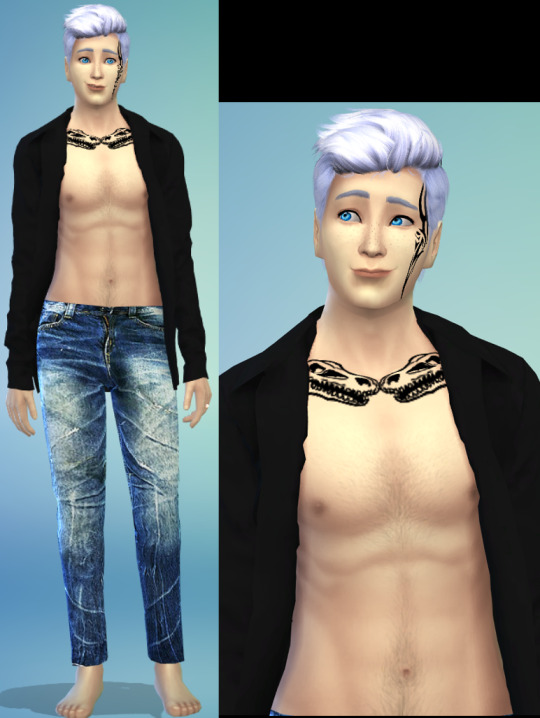
Colton, a shy cyborg cutie. Is dating Myarel’s youngest sister Keida. Doesn’t like talking about his dad all that much. His right arm from the elbow down and his legs from his knees to about the soles of his feet are metal. His right eye has a small red dot in the pupil that grows when he experiences negative emotions.

Lyn, a blind, polyamorous Southern gentleman. Flirty and independent, and will whack you with his cane if you do something he doesn’t like. Lives with his three lovers on his farm. His father was a fairy, and his mother was a Shadow Demon. He has wings, but rarely exposes them, and can do a bit of magic.
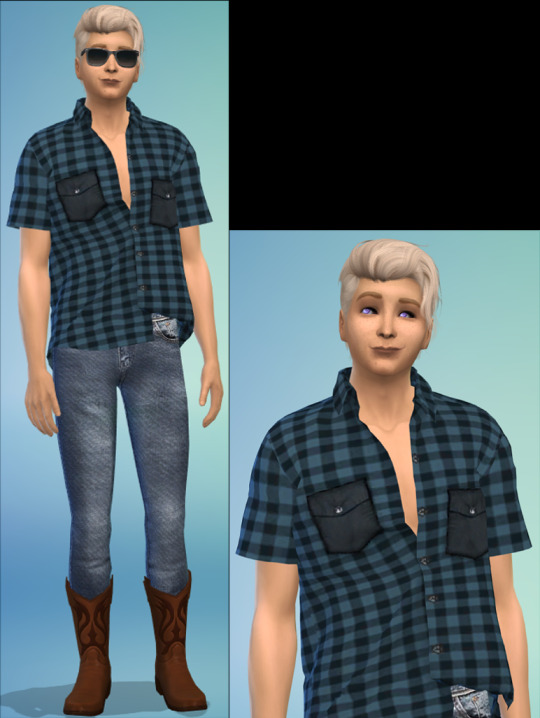
Isaac, a gay former pirate. Prankster, makes stupid jokes, and can often be irritating, but still a sweetie. Adores his boyfriend. Helps Lyn out on his farm, and still loves the sea, though the land will be his home from now on.

Vi, a vampiress. Myarel’s wife and mother of their triplets. Is often told she looks like her grandmother. Adores her family, and acts as an older sister to her younger cousins.
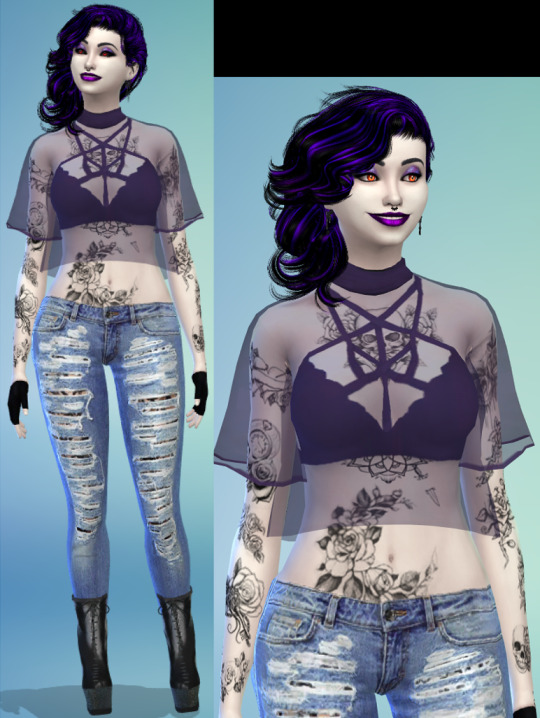
Rose, Vi and Myarel’s daughter. A total Daddy’s girl, and the oldest of the triplets. (She and her siblings are shown here as teenagers, around 14.)

Viktor, Vi and Myarel’s son. Very close to his mom, and the youngest of the triplets.
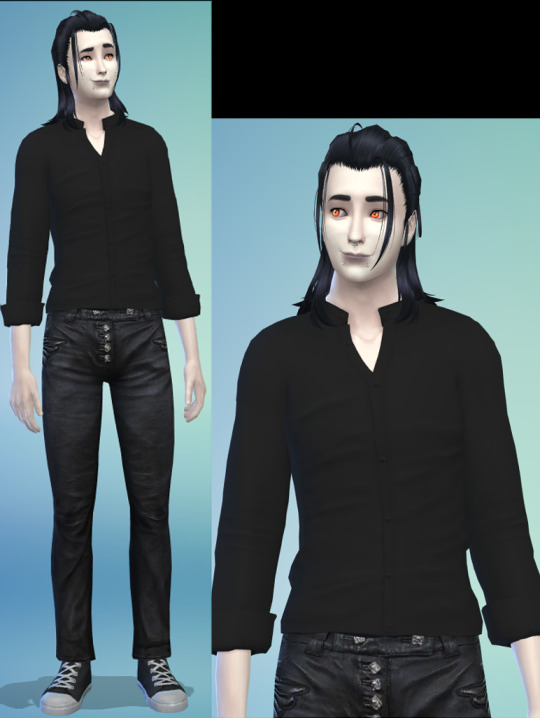
Axel, Vi and Myarel’s son. As the middle child, he loves to mess with his siblings and parents alike, but he’s still sweet.

Dormir, one of Lyn’s lovers. A vampire who was born with double fangs, giving him a slight lisp. Is protective of his little sister.

Estrella, a mermaid. She’s engaged to Tiburón, and is another of Lyn’s lovers, as well as the mother of the quartet’s children.
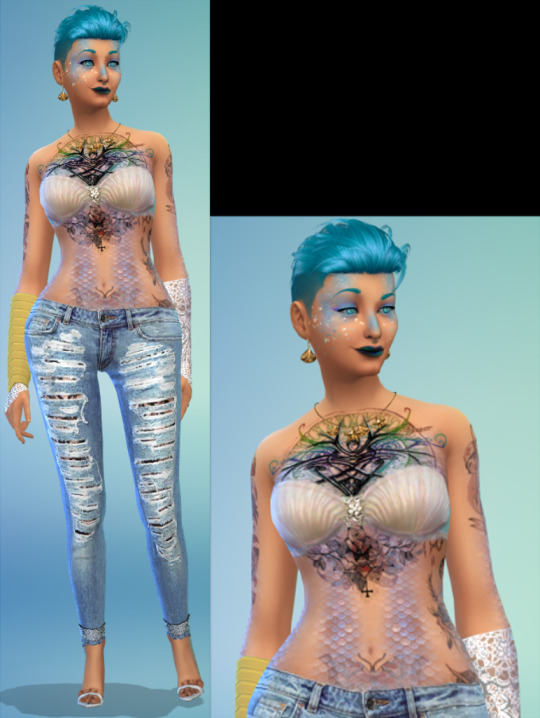
Tiburón, a merman. Engaged to Estrella since they were young. Is mute, and speaks through sign language.
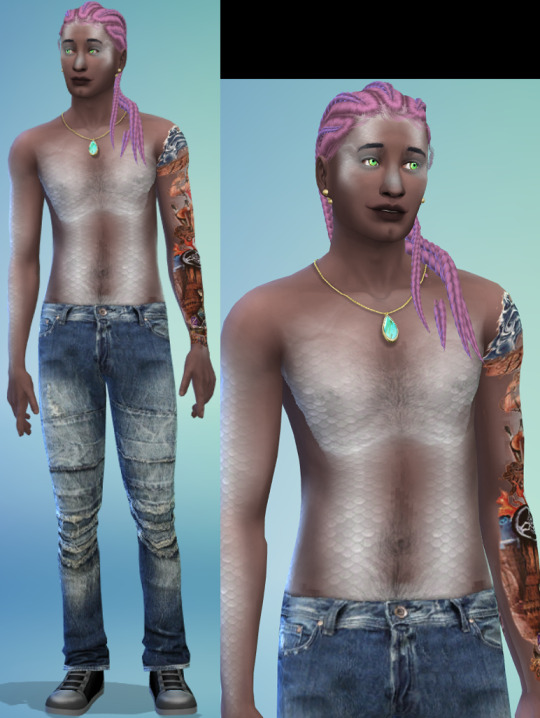
Aria, a young vampire, shown here as a teenager. Dormir’s younger sister, and admirer of everything he does.

Esteban, Estrella and Tiburón’s son. Oldest of his siblings, protective over them and Aria alike. (He and his siblings are shown as teenagers here.)

Angelita, daughter of Dormir and Estrella. The middle child of her siblings, she adores all of her parents, and especially adores her aunt Aria, who is more like a sister to her.

Cristobal, son of Estrella and Lyn. Shares his father’s eye color, but not his blindness. The youngest of his siblings, very close to his father.
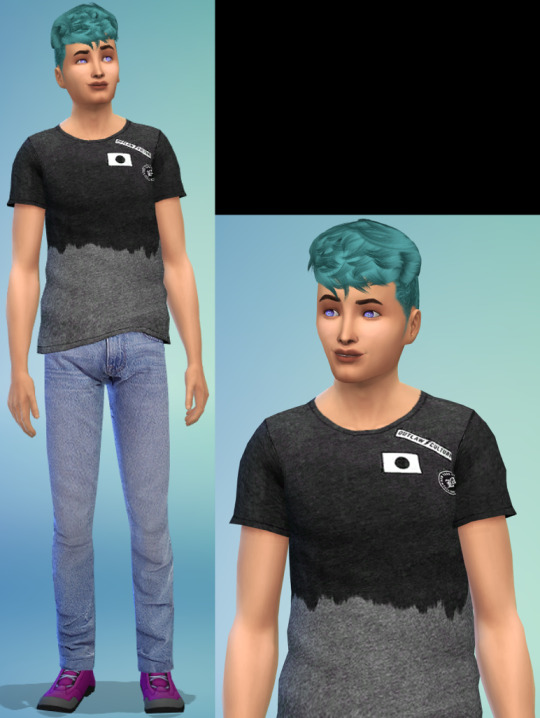
Erika, Isaac’s older sister. Is kind of a social media celebrity, but she doesn’t care about fame as much as she cares about her brother and father.
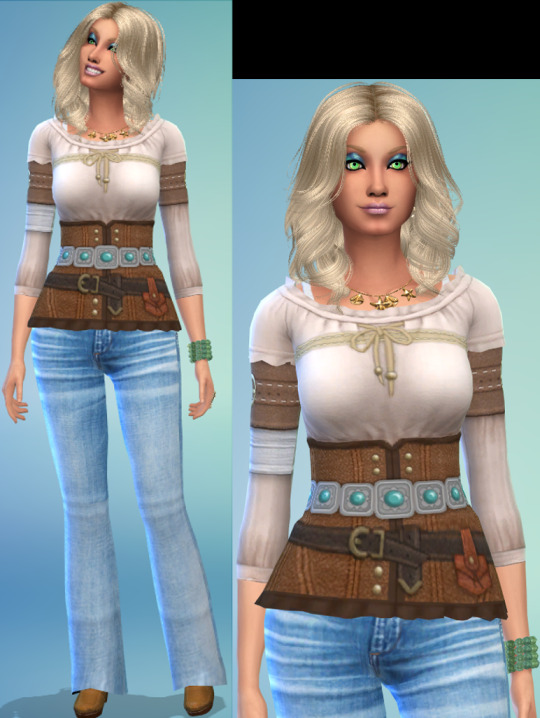
Xalia, Myarel’s oldest sister. Likes bright colors, and is sometimes snappy, but cares more about her siblings than anything else.

Zukari, the middle child in Myarel’s family. Quiet, kind of shy, and bad at talking to people. More open around his family than around strangers.

Keida, Colton’s girlfriend and one of the two second-youngest kids in her family. She and Kikaru are twins. She’s more confident than both her brother and her boyfriend and makes them be social.

Kikaru, Keida’s twin and one of the second-youngest kids in his family. Doesn’t enjoy being social, but as he and his sister are usually together, he’s better than he used to be.
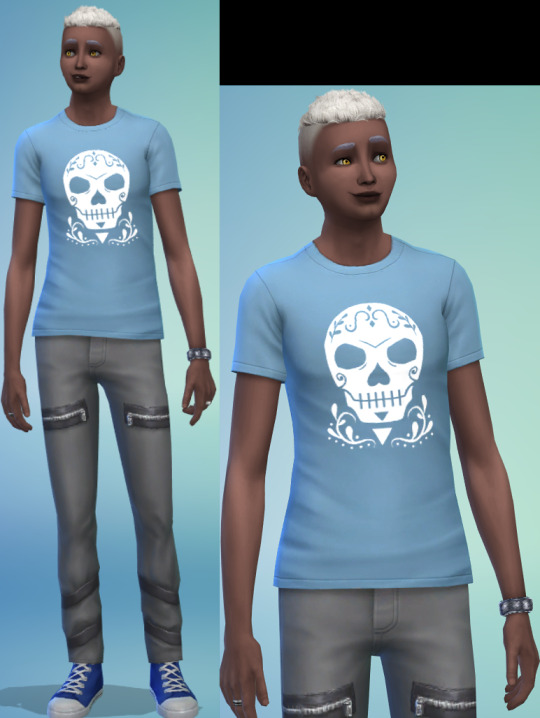
Zexion, the youngest child of Myarel’s family. Prefers spending time birdwatching rather than making friends, but is always joined by someone else in his room eventually.
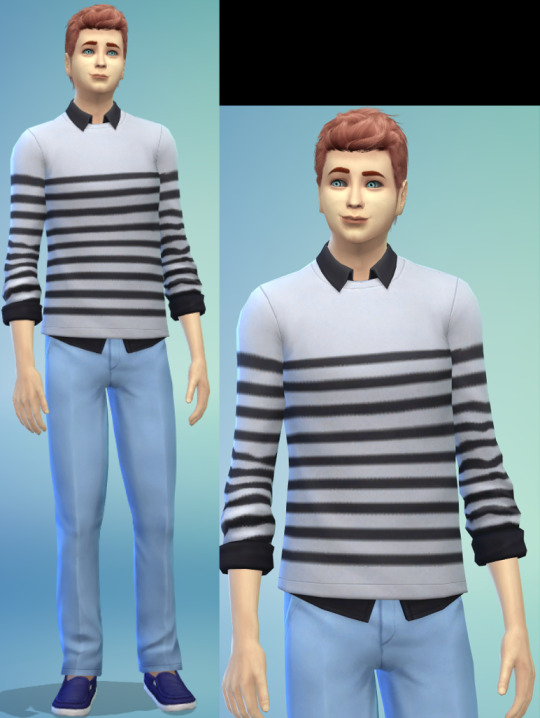
Hexxian, Myarel’s oldest cousin. His nickname is Hexx. He was one of a set of quadruplets, but his sisters died in utero. The spirits of his sisters matured with him, and he’s always had their guidance. Married to Opal. His mother is a Shadow Demon, and his father is a warlock.

Opal, a rare Prism fairy, Hexx’s wife, and Lyn’s former guardian. Kind-hearted and soft-spoken, but not as delicate as she seems. Has helped Lyn glamour part of his farm so he can keep magical creatures in it.
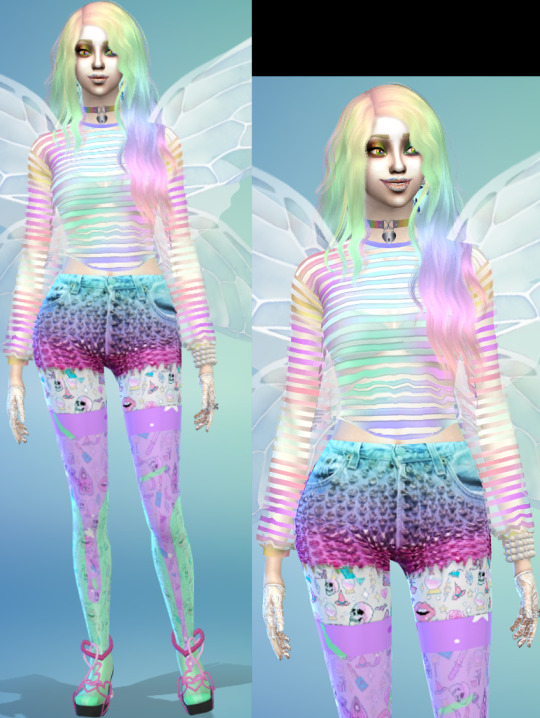
Tarja, Myarel’s cousin. The oldest of her siblings. In the band she and her brothers made together, she plays bass and provides vocals. Genderfluid, mostly presents as female and accepts he/she/they pronouns. As a shapeshifter, she can take any form she wishes, though her eyes stay the same. She and her brothers are Shadow demons.

Xandon, nicknamed Xan. Oldest of Tarja’s brothers. Quiet and bookish. Plays piano and synthesizer for his family’s band.

Nexxan, nicknamed Nexx. The middle child in his family. Hyperactive, funny, and always full of energy. Plays drums in his family’s band.
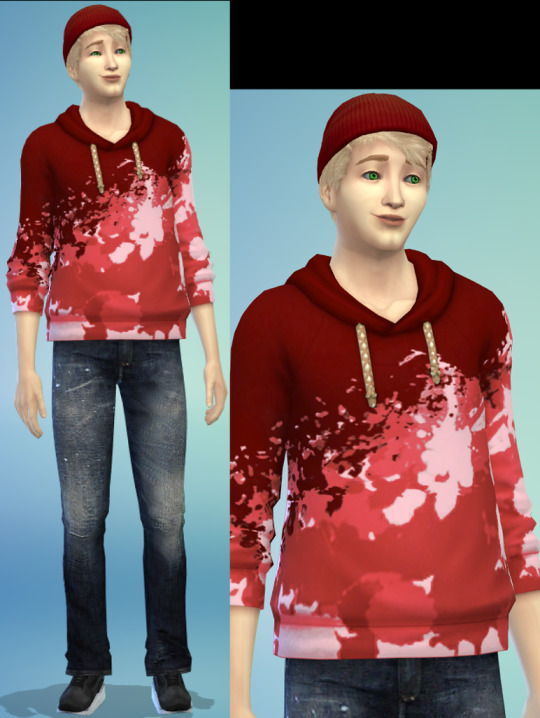
Vixaine, nicknamed Vix. Second-youngest in his family. Unlucky in love, but believes he’ll find the one someday. Provides lead vocals in his family’s band, and can also play guitar.
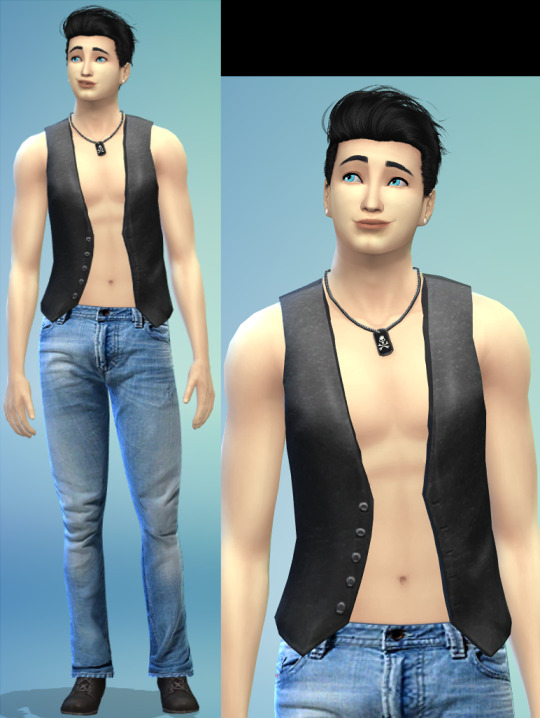
Mizane, nicknamed Zane. The youngest in his family. Shy, sensitive, and very attached to his sister. Very rarely sings, but he can. Taught himself to play guitar, and plays it in his family’s band.

Draiman, Myarel’s cousin. Goofy and outgoing, always looking for ways to bug Myarel, but genuinely cares about him. Oldest of his siblings, first to move out of his family’s home. He and his siblings are Shadow demon/ Water demon hybrids.

Liberty, Draiman’s oldest sister and second-oldest in her family. Independent and always creating her own fashion trends. Can’t wait to move out.

Quill, Draiman’s brother. A bit lazy, but mostly just laid-back. Doesn’t worry about anything, even school, but still gets good grades.
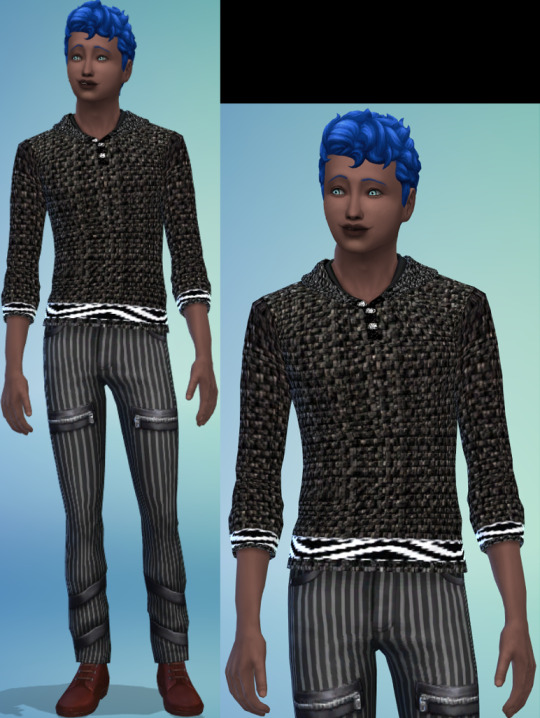
Ingrid, Draiman’s youngest sister. Optimistic and outgoing, and always looking forward to tomorrow.
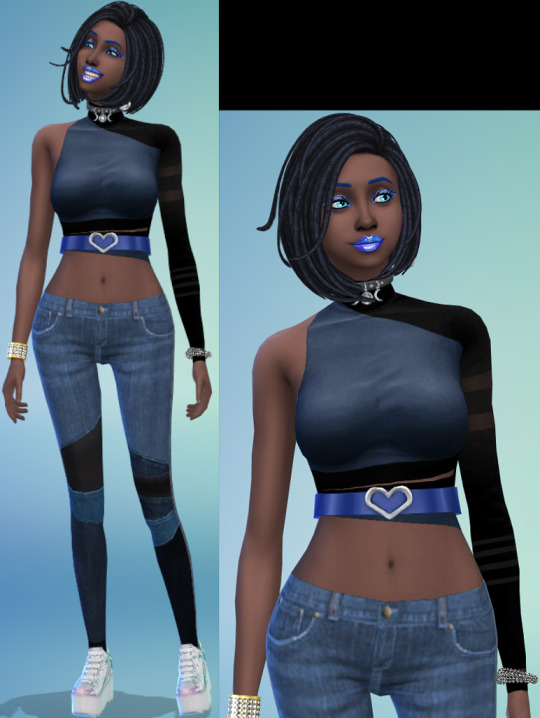
Rowan, a vampiress. Adoptive mother of Colton and Myarel, grandmother of Violet, and great-grandmother to Vi and Myarel’s triplets. She considers herself the mother of anyone who needs one. Youngest of her 12 siblings, and one of the two who survived. Kind and cares for her family.

Everett, aka my self-insert. Isaac’s boyfriend and Rowan’s grandson. Transgender and gay. Is the only one who can successfully play pranks on Isaac without him suspecting anything. Outgoing and always looks out for his twin brother. He and his brother are half vampire and half shapeshifter, and he can shapeshift into a white Cheetah.

Ethan, Everett’s twin and Xan’s boyfriend. Quiet, shy, and mostly scared of new people, but his brother drags him along when he feels he needs to meet people. Despite his shyness, he’s still sweet as can be. Can only shapeshift halfway into a white Cheetah, meaning he has all the characteristics of the Cheetah, but not the body.

Hickory, a shapeshifter that can turn into a Barn Owl, shown here in human form. Is often Rowan’s companion, though she doesn’t know he’s a shapeshifter and thinks he’s a normal owl. Is around 15 years old in human form. Knows he’ll have to come clean to Rowan eventually.

Jolene, nicknamed Buttercup. A Fire demon/succubus hybrid who abstains from using her seduction. Wears her mask to hide facial scars. Zukari is her boyfriend, and she loves him dearly. Also loves her two adopted siblings, Ren and Selene. Mistrustful of most people, but can come around eventually.

Selene, nicknamed Twitch. A Lightning demon/succubus hybrid who hasn’t used her seduction once in her life-- she’s terrible at it, it turns out. Nexx is her boyfriend, the only one who can keep up with her motormouth. Loves making new friends, very hyperactive.
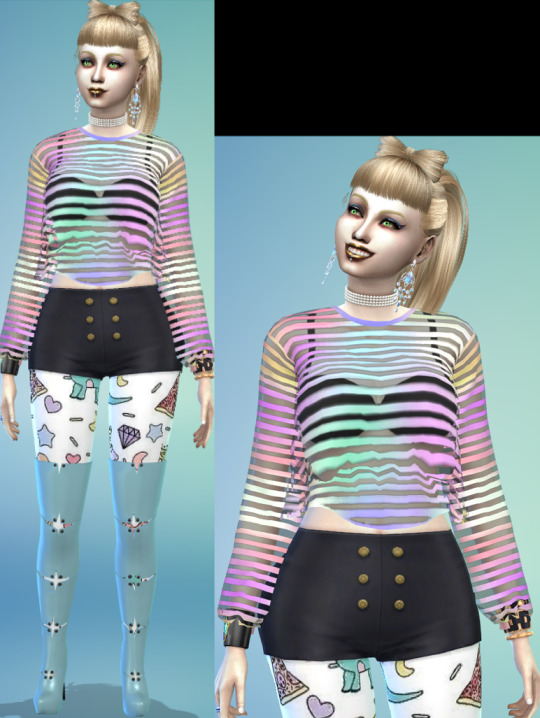
Ren, nicknamed River. A Water demon/incubus hybrid, great at seduction but more content to make friends the normal way. Doesn’t talk much, but is willing to make friends. Despite being the same age as his sisters, he’s extremely protective over them.

Chris, a ghost. Was murdered, though he doesn’t remember who did it. He still has the scars on his chest, but he really isn’t looking for his killer. He’s just happy spending his days with his husband, Paul. Very mischievous, but only toward people he knows.

Paul, a ghost. When he met Chris he was alive, but he won’t disclose his manner of death to anyone, not even his husband. Is a DJ, and is super friendly despite his tendency to scare people who are unprepared.

Chimaera, a humanoid Chimera (lion/goat/snake), seen in a form closest to their normal one. Gender-neutral, will accept any pronouns but prefers they/them. It’s unclear if they choose not to speak, or if they just can’t. Shy and rarely wants to be around people, though they’re comfortable around Lyn.

Dee, a werewolf. She was born as a werewolf rather than turned into one, and as such she can become a wolf at will. Outgoing and loves to meet new people, and of course, loves sparkly things.

Wisteria, a Nature fairy. Lives with Draiman, though the two are just friends. Always surrounded by butterflies, and where her bare feet tread, flowers spring up. Rarely shows her wings to anyone. Is comfortable around people, but is more comfortable around nature.

Amelia, currently a zombie, formerly a shapeshifter who can become a Barn Owl-- and Wisteria’s younger sister. Doesn’t remember her real name, but people who’ve met her gave her the name Amelia. Very shy, and can hardly speak as her voice is raspy. Her cause of death is unclear, but she’s not decaying. Loves animals and doesn’t like killing anything or anyone.
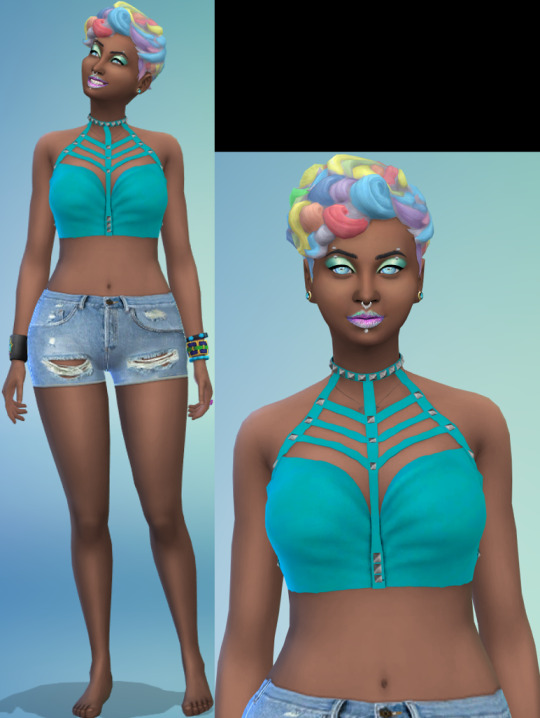
Emily, Amelia’s girlfriend and the daughter of two gay men. She’s outspoken and takes no shit from anyone. Is very strong, and can lift her tiny girlfriend above her head. Thought zombies were all mindless until she met Amelia. Hopes to find a cure one day.
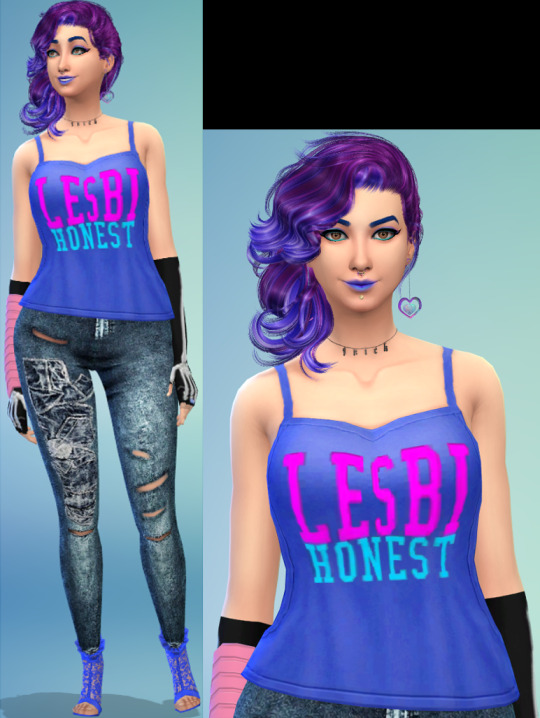
Erin, a dragon shapeshifter and distant cousin to Ethan and Everett. Reclusive, as his temper is not something he likes to show people due to his inability to control his shapeshifting when he’s angry. Is very close to Dementia, who has become his assistant and companion over the years.
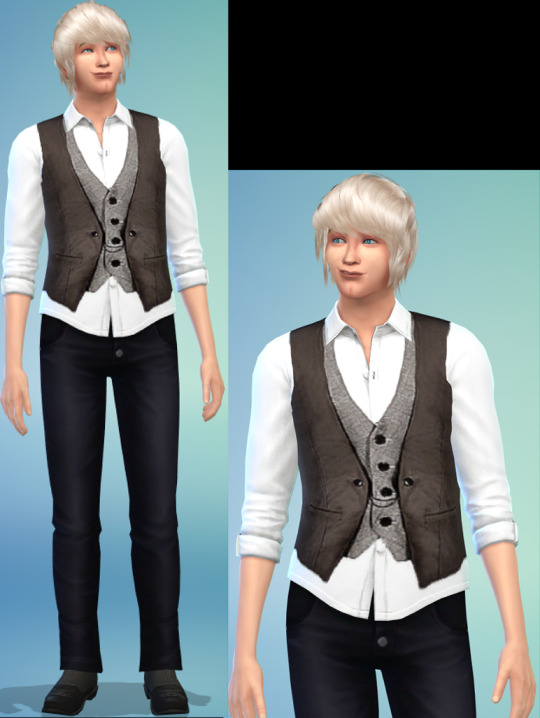
Dementia, a Mist demon. She feels a connection to Myarel, though why she feels it is unknown. Has grown close to Erin, helping calm him down when his temper flares and coaxing him out of his dragon form. Hopes to be able to approach Myarel someday, but for now is content helping Erin.

Journey, aka my newest OC. A deer-inspired ball-jointed doll given life by Erin. Is quiet as she doesn’t know how to speak yet, but is also very stubborn. Assists Erin and Dementia when she can, but is independent and longs to explore the world.
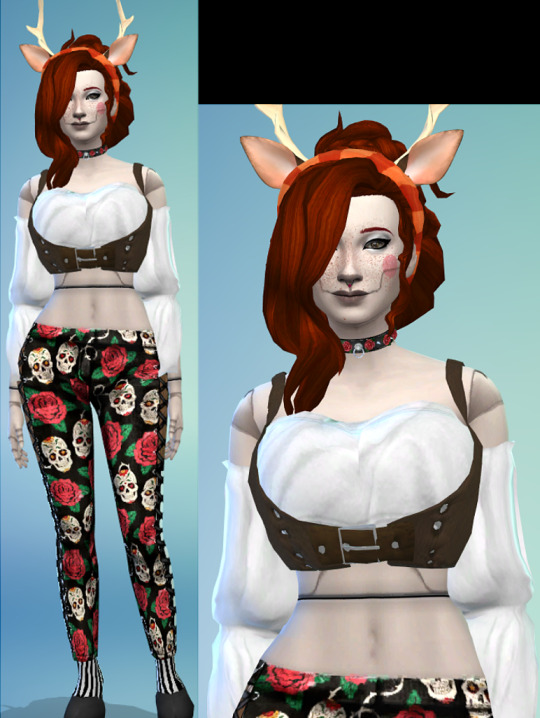
#this took a while fdsklfj#if you want to see more of some of them#like the rest of their outfits or anything#let me know!#I might do one of those things#where I make a color scale and highlight their tickle spots :P#anyway!#enjoy the majority of my children :3
6 notes
·
View notes
Text
Queer Positive Deities

Keep in mind that this is NOT a complete list of ALL pantheons and deities that are queer positive. This is a good majority, but by all means it is NOT all of them. Also not all photos would fit.
DISCLAIMER
This wiki will contain sexual terms and other mature items that each deity represented or did in their specific pantheon. If any of it bothers you, please exit the wiki and move on from it. Thank you.
Achilles (Greek)
The Greek hero Achilles was invulnerable excepting his famous weak heel, but a male shieldbearer broke through the warrior’s romantic defenses. While Homer never explicitly states a gay relationship between Achilles and sidekick Patroclus, many scholars read a romantic connection between the two, as only Patroclus ever drew out a compassionate side to the famously arrogant warrior. Patroclus’s death at the hands of Trojan Prince Hector sent Achilles into a rage in which he killed Hector and dragged his body around Troy. Other myths also disclose Achilles was struck by the beauty of Troilus, a Trojan prince.
Adonis/Tammuz (Phoenician/Greco-Roman/Mesopotamian)
The name “Adonis” now refers to a strikingly beautiful male, but the original Adonis is a cross-cultural deity, showing up in Phoenician and Greco-Roman mythology. Adonis is often equated with the Mesopotamian Tammuz, with whom he shares many attributes and stories. Most noted for his relationships with goddesses, including Astarte, Aphrodite, and Persephone, Adonis was also the beloved of the god Dionysus. Adonis and Tammuz are fertility gods, representing the vegetation of the land, in a constant state of life, death, and resurrection. Adonis died from a boar’s attack, which mutilated his genitals. In the much-celebrated descent-of-the-goddess stories known in many cultures, the Goddess travels into the many layers of the underworld to retrieve the spirit of her consort. Adonis is seen not as a king, but as a lover, somewhat effeminate or homoerotic. His priests in Athens were homoerotically inclined, and, along with priestesses, they celebrated his life and death by planting gardens of Adonis, and then uprooted them only a few days after sprouting. In the Greek magical papyri, Adonis is invoked for lesbian love spells.
Antinous (Greco-Roman-Kemetic)
This resurrection figure holds ties to ancient Egyptian, Greek, and Roman cultures. Antinous was a real historical figure and the male companion of the Roman emperor Hadrian. The pair would take journeys around the Mediterranean. And on one trip, Antinous drowned in the Nile on the same day that Egyptians commemorated the watery death of Osiris. Deeply affected by the death of his lover, Hadrian encouraged the deification of Antinous, and cults sprung up around the Mediterranean honoring him. In some tellings, Antinous rose from the Nile after his death and was then revered as a form of Osiris reborn. Indeed, the god and the Roman cult that followed him still have devotees today.
Apollo and Hyacinth (Greek)
Apollo was initially the Greek god of light and later was associated with the Sun. His twin sister is Artemis. As the god of music, dance, divination, healing, and artistic inspiration, he can grant these gifts to others. Apollo is known for taking many male lovers, most notably, Hyacinthus, or Hyacinth, a mortal youth. When he was tossing the discus with Apollo, it struck Hyacinth with a mortal blow. The western wind god Zephyrus, who desired Hyacinth and was angry and jealous of Apollo, caused the accident with his winds. The Sun god could not save his beloved, but from his wound Apollo created the Hyacinth flowers, a symbol of youth cut too short. Hyacinth later became a divine patron to those pursuing same-sex love.
Aphrodite/Venus (Greco-Roman)
Aphrodite embodies the powers of love on every level, especially romantic love. Known as Venus to the Romans, and associated with the morning and evening star, the planet Venus, she was renowned for her gifts of attraction and beauty. She originated—along with the Furies—from Uranus, the sky god, springing forth from the foamy sea where Uranus’s genitalia had fallen after being castrated by his son Chronos. She is usually displayed as a beautiful woman rising out of the sea, as in Botticellis painting, “The Birth of Venus.” As she walks on land, she trails flowers behind her, even in the most barren of deserts. Her aid Eros is the original archetype for the Valentine’s Day cupid, shooting his arrows and making people fall in love. She had many lovers, most notably Ares the war god and her husband, Hephaestus. She bore Hermaphrodite from her union with Hermes.
Artemis/Diana (Greco-Roman)
Artemis is the huntress, the goddess of wild things, the protector of women and children, and the maiden aspect of the Moon. From her bow, she fires silver arrows, the shafts of moonlight to illuminate her path. In many versions of her myths, she is the archetype of the strong, independent woman, goddess of Amazons and unsympathetic to those of traditional masculinity. After her birth, she immediately got up and helped her mother deliver her twin brother, Apollo. Artemis rejects many traditional roles, such as marriage and conventional society, and feels kinship to those beyond traditional roles. Her festivals included same-sex eroticism involving both females and males. As the Romans’ Diana, she took on a more maternal, universal goddess archetype, and became the mother of Aradia, her avatar in 14th-century Italy, who taught the Goddess’s craft.
Astarte (Phoenician/Canaanite)
Astarte is a manifestation of the Great Mother Goddess of the Paleolithic cultures, identified with the earlier goddesses Ishtar and Inanna, and later the Greco-Roman Aphrodite/Venus. Versions of Astarte were worshiped throughout the Middle East, Egypt, and even across Europe, with the spread of the Roman Empire. She is a Queen of Heaven, and patron of love and war. She, too, is involved in the resurrection and fertility myths of Adonis, also known as Adoni, or lord. Though usually remembered in feminine form, like other goddesses, she does have mixed gender incarnations, sometimes depicted as a hermaphrodite, and later the Phoenician records mention King Astarte. Astarte’s temples were served by the kelabim and possibly a gender-variant order of Amazonian women.
Athena/Minerva (Greco-Roman)
Springing fully formed from the head of Zeus, without aid of a goddess, Athena is presented as the wise warrior woman of the Olympians. She has the ability to transform into a young man. Her affairs often end on a tragic note, and most modern myths present her as celibate, though such descriptions were probably added by the patriarchal rise, to demonstrate a strong warrior woman could not have love. In one such myth, her “brother” Hephaestus makes her armor, for “her love.” He means physical love, while she assumes platonic love. I find it hard to believe such a goddess of wisdom and strategy would misunderstand such an offer. Most likely, our modern Athena is a sanitized version of the ancient Minoan snake goddess. Her darker half was shed and cast off as the gorgon Medusa. Modern Athena carries a shield with Medusa’s face on it. Athena is the goddess of strategy, weaving, and invention, who is credited with teaching humans how to graft olive branches onto trees, yielding more harvest. The city of Athens is named after her. She is often called Pallas Athena, in honor of her friend (or possible lover) who died as a youth in a spear throwing accident. Minerva is her Roman name.
Atum (Kemetic)
In the creation story for the Egyptian gods, the first deity, Atum, was both male and female, according to studies by researcher Mark Burstman. The ancestor to all self-produced two offspring, Shu and Tefnut, through either a sneeze or his own semen, and it wasn’t for a few generations that the archetypal male and female gods of Isis and Osiris were born.
Baphomet (Europe)
Baphomet is not a traditional pagan god, but one most noted for its link to the Knights Templar. Pictured as a hermaphrodite, with breasts and a penis, Baphomet was also a mix between human and goat, a perfect mix between male and female, human, and animal, although something akin to the traditional Middle Age view of the devil. Baphomet is a deity of fertility and wealth. To curb their growing power and influence, King Philip IV of France claimed the Knights Templar were worshiping Baphomet and practicing homosexuality, two acts of heresy in the eyes of the Church.
Baron Samedi (Vodoun)
The Voodoo loa (law) named Baron Samedi is a god of the dead and magick, but is also evoked for help in daily life. His place is the cemetery and his symbol, a skull. Samedi is depicted as transgendered, wearing a combination of men’s and women’s clothing of black and purple, possibly representing his walk between two worlds, the living and the dead, in the same way that his sunglasses, with only one lens, do. He sees in both worlds. The Baron is known for his sexually suggestive movements indicating a desire for anal intercourse.
Bona Dea (Roman/Italian)
Bona Dea is the “Good Goddess” about whom little is known. She is a goddess of healing, magick, prosperity, and women. In fact, her cult did not allow the participation of men, and none of her mysteries were to be shared with the outside world. Most of our information on Bona Dea comes to us from the written accounts of male scholars lacking a personal connection to her rites. Her ceremonies possibly included lesbian acts of love as a part of worship.
Bran (Welsh)
Bran the Blessed is a Celtic hero/god of the mystical otherworlds. In many Celtic myths, the line between divine and mortal, spirit and flesh, is less visible than in most other mythologies. The legends were passed on orally, and recorded only much later by Christian writers. To preserve the story, yet not blaspheme, the gods and goddesses were transformed into heroes of folktales as the stories are told and retold. Bran is a patron of magick, battle, and resurrection. His main tale is the rescue of his sister, Branwen, who in many ways seems like his feminine half. She was abused by Matholwch, her husband and king of Ireland. Bran’s army defeated Matholwch’s men and rescued her, but Bran was fatally wounded. His head was eventually severed and continued, after his death, to speak and give magical advice. Eventually it was buried in London. As an interesting note to his history, Robert Craves, the somewhat controversial author of The White Goddess, believed Bran was worshiped by an order of homosexual priests, and Amathon, a version of the Green Man, wrests Bran’s secret magical name by seducing one of Bran’s priests.
Cernunnos/Herne the Hunter (Celtic/Proto-Celtic)
Cernunnos is the fabled Horned God, a central figure in modern witchcraft. He represents the god of the waning year and animal lord, the complement to the Green Man. Usually depicted naked, sitting in a lotus position, with stag antlers and a torc (Celtic neck ring resembling a choker) around his neck and one in his hand, surrounded by the animals of the forest. Some renditions portray the Horned God with an erect penis, surrounded by men with erections as well. Very little of Cernunnos’s original mythos survives, so old are his cults. Worship of him, primarily in Caul and other Celtic territories, is believed to predate the arrival of the Celts. We don’t even know his proper name; Cernunnos is a Roman variation. He has been equated with Herne the Hunter and even the Greek Pan and Dionysus due to their similar associations with nature and shamanic trance work. Herne is a figure of British folklore, the God of the Wild Hunt, appearing at times of crisis. Cernunnos is sometimes associated with the chalk carving of the god figure at Cerne Abbas in Dorset. The figure is not horned, but associated with fertility, due to his depiction with his exaggerated phallus. Cernunnos is an aspect of the Great Father God, a force of nature, like the Goddess—loving, gentle, and receptive, but also fiercely protective and powerful.
Chin (Mayan)
Chin is described as a small child or dwarf, and is a deity of magick, divination, and the destiny of rulers. He introduced homoerotic relationships to the Mayan nobles. The nobles would obtain youths of the lower classes to be the lovers of the nobles’ sons. Such unions were considered legal marriages under Mayan law.
Chrysippus (Greek)
Euripedes wrote that this divine Peloponnesian hero was on the way to compete in the Nemean Games when his Theban tutor Laius ran off with him and raped him. The incident drew a curse upon the city of Thebes.
Damballah (Vodoun)
Damballah is the serpent god of the Voodoo loa and although Damballah is portrayed as a father figure, he has an androgynous nature and can manifest homoerotically or bisexually. Invoked for guidance, peace, and prosperous good fortune, Damballah is the god of rain and rainbows, making a modern connection to the queer rights movement.
Dionysus/Bacchus (Thracian/Greco-Roman)
Dionysus is the son of Zeus and a mortal woman named Semele. Myths paint Zeus’s immortal wife, Hera, as the villain, tricking Semele to her death while she was still pregnant. Zeus could not save her, but saved his child, and implanted the unborn child in his thigh, carrying him to term. Thus, in this myth, Dionysus is “twice born” and associated with immortality and Zeus is transgendered and associated with birth. Older myths cite Dionysus’s early death and rebirth, as well as a serpent, perhaps Persephone in disguise, as his mother. Hera plagued him after his birth, so to disguise himself, he learned the art of shape shifting into various plants and animals and dressed in women’s clothing to avoid detection. He kept company with woodland creatures, depicted as soft and feminine, yet virile and strong, Dionysus is a balance of extremes. His myths, too, contain both ends of the spectrum. As a god of ecstasy, wine, and love, he traveled the world with his teachings, before ascending to Olympus as one of the twelve main deities. Like Jesus, but predating him, Dionysus spread his message and gathered followers to his cult. Some expressions were peaceful and loving, while others were more extreme and violent. His female followers of the more extreme rituals were called the Maenads, or Bacchante. Noted for his associations with Aphrodite and Persephone, taking a sacrificial Adonis-like role in several stories, Dionysus was less well known for his love affairs with men, including Adonis and Hermaphrodite. Dionysus is both an upperworld god of light, as a newborn child of innocence, and one who has braved the underworld, in search of his mother’s spirit, to come back with the power the shamanic realms has to offer. As Bacchus to the Romans, this god was depicted less beautiful, and more masculine, yet he retained his softness and sensitivity. Dionysus is quite the example of balancing gender identities as a path to enlightenment.
Ereshkigal (Sumerian)
Sister to Inanna, and Queen of the Underworld, Ereshkigal is the dark goddess of the dead. She is like the crone, and associated with the power of transformation and destruction, with Greek Kore/Persephone, Hindu Kali, Celtic Morgan, and Norse Hel. In Egypt, Ereshkigal was petitioned for gay male love spells.
Eros (Greek)
Eros is most popularly known as the cupid image of Valentine’s Day cards, and as the aid to Aphrodite, shooting arrows to make mortals and gods alike fall in love. The mythic, truly worshiped god Eros is much different from our conception of him. Like Dionysus, he contained a mixture of feminine and masculine energies, being soft, gentle, loving, effeminate, and childlike on one hand, and ancient, wise, aggressive, and masculine on the other. Eros is the patron and protector of homosexual love. He, along with Hermes and Hercules, could grant blessings upon male couples—the gifts of loyalty, eloquence, and strength, respectively. Eros is a major deity in the Orphic Mystery Schools, associated with the dolphin, flute, lyre, rose, and rooster. As a patron of success in battle, he was called upon by warrior/lovers before a fight, because many in the Greek world believed the love men had for each other would unite and lead them to victory.
Erzulie (Vodoun)
Erzulie is the Voodoo loa of love, seduction, and beauty, who grants the gift of manifesting beauty to those in the creative arts, such as painters, musicians, poets, and designers. Although similar in some ways to the Aphrodite archetypes, Erzulie also contains darker elements akin to the underworld goddesses. Her symbol is the mirror, not only to admire her beauty, but in Voodoo, the mirror is the symbol of the spirit world, the gateway to the realm of the loa. She is sometimes known as a loa of tragic love, for she is Erzulie Ge Rouge, Erzulie of the Red Eyes. She weeps constantly because no man can love her enough. Some practitioners consider her a patron to gay men and lesbians. Men “ridden” by Erzulie often display transgender traits.
Freyja (Norse)
The Norse myths divide the gods into two tribes, the Aseir and Vanir. The Vanir tribe is considered earthier, embodying the natural forces. The Aseir represent the more intellectual aspects demonstrated by sky-god cultures. The two tribes clashed and eventually the Aseir won the conflict. As a sign of peace, the tribes traded members. Freyja and Freyr lived in Asgard with the Aseir as part of the agreement. Freyja is the good goddess of these ancient people who would become the Norse. She is the goddess of the land, fertility, eroticism, and magick. She specialized in a shamanic magick called Seidr, the practice of inducing shamanic states through shivering and shaking, and sex magick acts are also attributed to her. She wears the golden falcon cloak, which carries her into the otherworlds like the bird of prey. Freyja taught her magick to the god Odin, the all-father of the Aseir. This great goddess later became a goddess of battle, and her initiations included the rite of boys becoming men and warriors. Although modern practitioners of the Norse traditions, the Asatru, are often seen as dominantly heterosexual and sometimes even unwelcoming of gays, it appears possible their ancient spiritual ancestors had homoerotic overtones in actuality, or ritually, like most ancient cultures. Becoming a warrior was a form of blood brothering. Ritual anal intercourse may have been a part of that warrior bonding.
Freyr (Norse)
Her brother, the god Freyr, also embodies the earth, like a vegetation king, growing, dying, and then resurrecting. Sharing attributes with the traditional Wiccan horned and green gods, Freyr is sometimes depicted with an erect penis, and fertility icons are present as part of his worship. He is also a patron of magick, shamanism, water, eroticism, love, peace, boars, horses, and stags. Freyr seems to keep his associations with peace, an association many queer men identify with instead of focusing on the more patriarchal and warlike gods, while other gods, including his sister, were directed toward war. His priest may have been homoerotic or transgendered, and well versed in his sister’s form of shamanic magick. In many ways, Freyja and Freyr are like two sides of the same coin, even in name. To modern pagans, they represent the primal Goddess and God of the land, the Lady and Lord seen all over the world
Ganesha (Hindu)
Ganesha, the breaker of obstacles and binder of evil, is usually depicted as a four-armed, plump, elephant-headed man, riding a rat. Ganesha is a benefactor, a wise, gentle, and loving god, acting as an aide and intermediary for other deities of the Hindu faith. He is the son of the goddess Parvati. One myth claims his father is the god Shiva. Another says he was created by Parvati from clay and dust, to be both her son and servant. Lesser-known myths say he sprung from the union of Parvati with the goddess of the Ganges River, Ganga, or another handmaiden goddess. Shiva beheads him in a fit of anger, as Ganesha protects the inner chambers of Parvati. The goddess replaced his fallen human head with an elephant’s head. Shiva later gave control of his armies, his own power, to Ganesha. The inner chambers of the goddess represent the inner, sacred power, and the power of sexuality, as he is said to guard the root chakra, and kundalini. The gates to the kundalini energy are the vagina and anus, and the elephant-headed god has been linked to homoerotic forms of worship involving anal sex. Ganesha is mixed in terms of sexuality, masculine in gender, and as represented with the elephant’s trunk, but also is soft, tender, and portrayed with breasts. He opens the gateways that block our path, removes obstacles, and protects travelers. Speaking from personal experience, Ganesha is a powerful ally to have when overcoming challenges placed before you.
Ganymede (Greek)
The most famous male lover of the Olympian god-king Zeus, Ganymede was a prince whom Zeus coveted. Taking the shape of an eagle, Zeus snatched Ganymede up to Mount Olympus to be his lover and his cupbearer, pourer of the golden ambrosia, the nectar of the gods. Ambrosia, like other sacred liquids, is associated with semen. The sign of Aquarius is associated with Ganymede.
Gwydion (Celtic)
Brother to the Welsh warrior Gilfaethwy, Gwydion is an archetypal magician figure, whose attributes were later absorbed by the Arthurian legends in the figure of Merlin. Gwydion is a trickster, as well as a magician, associated with the Celtic otherworlds and rites similar to shamanism, shape-shifting, and transformation. To woo the lady Goewin from the warrior/magician/king Math, Gilfaethwy asked for Gwydion’s aid. Though greatly skilled, they failed, causing a war with the King Pywll. Math punished them by transforming them into animals of the opposite gender and having them mate, producing a deer, pig, and wolf, who were later transformed by Math into human men, the heroes Hyddwn, Hychtwn, and Bleiden. Gilfaethwy took the female role twice, but Math made them both retain their human consciousness within their animal incarnations, as punishment. The results, however, were quite
wonderful, creating three heroes. Such myths can construe an archetypal reality that preceded events of ritual transgenderism and homoerotic worship among the Celtic people. Only later, as the myth was retold to Christian audiences, does the same-sex union become punishment for misdeeds. Gwydion later guides the development of the warrior Lleu, much like Merlin did with King Arthur.
Hecate (Greco-Roman)
The archetypal goddess of the witches, Hecate is the triple goddess of magick, justice, travel, the night, and the crossroads. She guards the roads of travel, sailors, horses, dogs, and wealth. As Hecate Triformus, she is the one who is three, embodying maiden, mother, and crone, but is most often seen as the crone, the dark goddess of the underworld—the bringer of light or terrible darkness, as a goddess of blessings and curses. Her symbol is the torch, carried into the dark night. As a handmaiden to Aphrodite and Persephone, she is a goddess of love, evoked for gay male love spells going back to the 3rd century C.E. She is also linked with Diana and Proserpina by the Romans, as triple Moon goddesses, and with Artemis, Luna, and Persephone in various triplicies, by the Greeks. Though most typically viewed as a Greek goddess, worshiped by priestesses, her roots trace back to Thrace, and she was honored by gender-variant male priests called semnotatoi. The Romans did not change her name when they assimilated her from the Greek pantheon.
Heracles (Greek)
The famous hero had a number of male companions through his many trials. Among them: Abderos, who kept the mares of Diomedes for Heracles but was eaten by the beasts; Hylas, Heracles’ companion when he sailed on the Argo, who was eventually kidnapped by nymphs in Mysia; and Iolaus, who help cauterize the necks of the hydra when Heracles famously chopped off the beast’s many heads. Indeed, the relationship with Iolaus was enshrined in Thebes, where male couples of the day could be found “exchanging vows and pledges with their beloved at his tomb,” according to historian Louis Crompton.
Hermaphrodite (Greek)
Hermaphrodite is a deity of both genders, having a penis and breasts. One myth states Hermaphrodite is the child of Hermes and Aphrodite, hence the name, and contained the best attributes of them both. Another myth states a nymph named Salmacis pursued a mortal man who spurned her. She asked that she and the mortal be joined forever, and the gods did just that, fulfilling her exact words, and not her intention. The gods melted the two together into one being with both masculine and feminine attributes.
Hermes/Mercury (Greco-Roman)
Although called the messenger god of the Olympians, Hermes has a much greater sphere of influence. True, he is the god of travel, but he is not restricted to any place or role. When speaking to his father, Zeus, he asks to go anywhere he chooses, and takes the role of messenger and psychopomp, traveling between the heavens, Earth, and underworlds. A psychopomp is a guide for souls who takes the dead to the underworld, and new souls to Earth. The psychopomp is the divine archetype of the shaman and magician. As one not bound by traditional roles and obligations, he is free to go and do as he pleases. Hermes took male and female lovers as he desired. With Hercules and Eros, he is part of a homoerotic trinity. His son is the god Pan. Although a male deity, Hermes is androgynous, and carries a lot of boyish charm. Called “Mercury” by the Romans, and associated with Thoth of the Egyptians, Hermes was evoked during the 3rd century in Egypt for gay and lesbian love spells in Hellenistic (Greek) magick. Dill seeds are considered the “semen of Hermes.” Hermes is also credited with giving humans the gifts of writing, mathematics, music, geometry, games, gambling, gymnastics, and wrestling. He is even said to be the inventor of masturbation. Invoked for protection when traveling, Hermes is another Greek patron of the crossroads. He is the god of both intellect and cunning, and as a trickster spirit, he is a patron of thieves. The symbols of Hermes include the winged sandals and cap, the caduceus, and the wand. The caduceus symbolizes the currents of kundalini, rising in a spiral, and later pictured as a double helix, like DNA, or the currents of masculine and feminine energy blending together. Now it is the symbol of modern medicine, as Hermes is a patron of healers. Hermes is a versatile god of many talents, trades, and attributes.
Horus (Egyptian)
Horus is the avenging son and a savior figure, a divine child in the Osirian cults. Horus is the falcon-headed god. One of his eyes is the Sun and the other is the Moon. The son of Osiris and Isis, he revenges himself against his father’s murderer, his uncle Set. Although Horus and Set were in constant conflict until Horus’s eventual victory, one myth relates the story of oral intercourse between Set and Horus, and Set consequently gives birth to Horus’s child. The child is either the Moon god Khonshu or the scribe of the gods, Thoth. Thoth is also associated with the Moon and homosexuality, although in most stories Thoth predates Horus. Homoerotic reproduction is common between divine personages, and their union often signifies birth of a mystical truth rather than a physical child. This particular birth suggests that the child of light and the god of darkness, nephew, and uncle are really two sides of the same deity, much like the cyclical Oak and Holly King of Celtic myth. Unfortunately, many scholars interpret the saga of Horus and Set as the struggle of good versus evil.
Hypnos (Greek)
Popular in mythology is the story of the Moon goddess Selene, who loved the boy Endymion. Most versions tell us she was so distracted by her love that she failed to pull her Moon chariot across the sky, causing darkness and the phases of the Moon. The gods punished her by putting poor Endymion to sleep, yet she still visits, continuing the dark phases of the Moon. The underworld god Hypnos, god of sleep, also loved Endymion, and he put Endymion to sleep, so they may share time together through dreams.
Indra (Hindu)
Indra is the Hindu sky god, with many similarities to Zeus. Both bisexual and transgendered, Indra loves his wife, Indrani. Indrani and Indra are viewed as the feminine and masculine sides to one being. Indra also loves the Moon god Soma, who elicits comparisons to Ganymede. The word soma also refers to the drink of the gods, like the Greek ambrosia, an offering, or potentially a psychotropic substance, real or mythic, which opens the gate to the gods. Soma also forms a union with Agni, the Hindu god of fire.
Isis (Egyptian)
The most beloved of goddesses, Isis is the Great Mother goddess of the Egyptians, the mother of gods and pharaohs. As the goddess of the land, agriculture, Moon, heaven, the underworld, healing, and magick, she is essentially the goddess of life. Her worship started in Stone Age Egypt, but was later incorporated in the more patriarchal myths of Ra, Osiris, and Horus. Even so, she plays a pivotal part in such dramas. Her worship spread into Europe, particularly as a result of Rome’s contact with Egypt, and only diminished with the rise of Christianity and the violent conversions associated with it. Christianized emperor Constantine forbade her worship and rites, desecrated her temples and killed her priests and priestesses. Actually, she was worshiped almost twice as long as Christ has been, and modern pagans are reviving her worship. Her cults and mysteries may have been similar to or even inspired the Eleusian mysteries of Persephone and Demeter. Although associated with homosexuality through her son Horus and brother Set, Isis, like other goddesses of her time and place, is served in ancient times, and today, by gay and transgendered priests and priestesses. Priests of the ancient world grew out their hair and nails, wore skirts, engaged in ritual sex, fertility rites, and possibly ritual castration, all to the dismay of later Christian observers. As the Great Mother, she welcomes all genders, orientations, races, and classes to her worship, and is considered one of the most popular and well-known goddesses in the modern pagan movement.
Kali Ma (Hindu)
Known in Hindu myth as the destroyer, the warrior goddess, and devouring mother is Kali. She is a dark goddess of magick, tantra, thieves, warriors, and death, with many arms carrying weapons, skin like ebony, and wearing a necklace of human heads. She is the destroyer of demons, and the wife/mother of Shiva, the dissolver. In modern practice, Kali is the harsh mother called upon to destroy what does not serve, including our own egos and illusions. She is both beauty and horror personified, forcing us to face our fears. Most people misunderstand the power of Kali. She is not a monster. She is akin to the Celtic war goddesses and crones, like the triple Morgan and the Cailleach. In the Hindu traditions, she is like Mother Nature. Male worshipers sometimes dress as Kali, with fright wigs, masks, and dresses, or ritually cut themselves with swords, as a symbolic castration.
Loki (Norse/Scandinavian/Germanic)
Originally, Loki was a fire god, later absorbed by the Teutonic tribes. In Norse myth, he is adopted as Odin’s blood brother. As his myth changed over time, he was demonized much like the Egyptian Set was. Loki is the trickster, in the positive and negative associations of the word. Although oriented to fire and light, Loki is as much a mercurial figure as Hermes and Thoth, working in words and clever unpredictability, like a combination of The Fool and The Magician of the tarot. Later his words turned to lies and his pranks turned much more malicious, siding with the enemies of the Asgardian gods, causing the death of Balder, the Sun god, son of Odin and brother to Thor. Loki is credited with starting Ragnarok, the Norse Apocalypse the gods desperately tried to prevent. As a shape-shifter, Loki is associated with transgenderism. To help Thor recover his hammer, stolen by the giants, he dresses Thor as Freyja and disguises himself as “her” handmaiden. Later disguised as the giantess Thokk, he prevented Balder’s resurrection by refusing to cry for Balder and defying the goddess Hel’s vow to release Balder from the land of the dead if all would shed a tear for him. Loki also assumed Freyja’s form and cloak, indicating magical and shamanic associations with the goddess, although it appears Loki never had a cult or priesthood exclusively his own. He transforms to a mare, gets pregnant, and gives birth to Odin’s eight-legged magical steed Sleipnir. Because of it, Loki, as a male god, is associated with homosexual union, called “argr” by Odin, an abusive term in old Norse for a sexually receptive male. Related to the word “ergi” that may indicate a sexually receptive male and one versed in Freyja’s magick. Loki also fathered the Midgard Serpent, Fenris Wolf, and Hel, the goddess of death.
Macha (Celtic)
Macha is an aspect of the Celtic triplicity known as the Morgan. Her name means “battle” and she is associated with both the crow and the horse. Three Machas have appeared in Celtic myth. The first is the wife of Nemed. Another is Cimbeath’s wife, who becomes a war chief, herself. The last, and most unusual, is Macha, the wife of Crunnchu. She came to Crunnchu as a fairy lover, making him promise never to reveal her identity. She becomes pregnant with his child. Foolishly, Crunnchu brags to the King in Ulster that his wife can outrun any of the king’s horses. The king accepts his challenge, demanding Crunnchu’s head should the latter lose the bet. Macha, in her mortal guise, is forced to run the race, and she wins, immediately gives birth to twins, and reveals her divine nature, cursing the men of Ulster for their treatment of her. For nine generations, in times of great crisis, all the men of Ulster experience a feminine transformation, living the pains of childbirth. Such androgynous transformation could signify a strong goddess cult influence in Ulster, originally demonstrating not a punishment, but an understanding of the goddess Macha. Although a goddess of war, she is also a goddess of life and sovereignty, giving birth under harsh conditions. Both Emain Macha, Ulster’s capital, and Ard Macha are named after her.
Morrigu/Morrigan/Morgan (Celtic)
The Celtic trinity of war goddesses are known by the name Morrigu. One version contains the goddesses Anu, Babd Catha, and Macha. Another version consists of Babd, Macha, and Nemain. All are associated with battle and death, but also with life. On Samhain, the Morrigan mates with the Dagda, with one foot in the river and one on land, symbolizing the veil between the worlds opening as spirits pass through it. In the revival of modern witchcraft, she is one of the most popular Celtic goddesses, associated with the Great Mother of the Earth, sea, and cosmos. In later myths, she was transformed into Morgan Le Fey of the Arthurian legend, sometimes ally and sometimes villain.
Narcissus (Greek)
A figure mostly known for his obsessive vanity, this son of a nymph and a river god would spend his last days gazing at his own reflection, but the first man he showed affection for was not himself. A myth traced in origin to the Boeotia region mentions a relationship between Narcissus and the smitten Ameinias, whom Narcissus would eventually grow tired of before sending him a sword as a kiss-off. Ameinias, desperately depressed over the rejection, killed himself.
Nephthys (Kemetic)
While there are fewer tales in Egyptian history and mythology about female than male homosexuality, many considered the goddess Nephthys to be a lesbian. The sister and constant companion of Isis, she married brother Seth but bore him no children. Scholars have debated whether the stories of Nephthys, who did bear one son by Osiris, show that the culture held lesbians in greater esteem than gay men, because they could still be fertile despite their sexual orientation. Then again, others express skepticism about her lesbianism altogether.
Odin/Wotan (Norse/German/Scandinavian)
Known as Wotan the Wanderer in Germanic myth, Odin is the all father and king of the Aseir, the warrior gods of the Norse pantheon. Credited with creating, with his brothers, the nine worlds of the Norse cosmology Odin, is a god king and mercurial figure, a traveler, binder, and inspirer. Odin is very shamanic, hanging himself from the world tree to gain knowledge of the runes and giving his eye for knowledge. He is attended by two ravens—Thought and Memory—the head of Mimir who granted him knowledge, and the spirits of the warriors of Valhalla and the Valkyries. (“Valkyrie” means “choosers of the slain,” a group comprising of Amazon-like warrior goddesses acting as psychopomps to the souls of heroes, leading them to Valhalla.) He is the god of nobles, leaders, warriors, poets, magicians, and mad men, evoking a frenzy or fury for battlers. His son Thor is the chief god of the common folk. Odin is known to have assumed feminine dress and identity when it suited his purpose. Freyja initiated him into Seidr shamanic magick, a form traditionally reserved for women and transgendered/homosexual men. He is blood brother to Loki, and their bonding has homoerotic overtones, much like the process of warriors bonding in the rites of Freyja.
Orpheus (Greek)
The legendary poet and musician may be best known for the story of his journey to the underworld to retrieve his wife, Eurydice; he failed to do so when he succumbed to temptation and looked at her before both had returned to the world of the living. According to Ovid, he never took another female lover after that — but did love other young men in Thrace. Spurned, Ciconian women would eventually tear Orpheus apart during a Bacchic orgy.
Osiris (Egyptian)
Osiris is one of the few fertility gods of the ancient pagan world not specifically associated with homosexual relationships, as Adonis and Dionysus are. His only association comes from his brother Set and his son Horus. Originally a god of fertility, he is killed by his brother Set, and resurrected by his wife, Isis. Angered by his resurrection, Set dismembers him. Isis finds all the pieces, except his penis. She resurrects him, placing a symbolic phallus in the correct position. Because of his inability to create new life, Osiris becomes lord of the dead. Either prior to his second death, or through the magical workings of Isis after his second resurrection, he conceives a child with Isis, named Horus, who continues his battle against Set, with the aid of Anubis, Nephthys, and Thoth, and eventually wins, becoming the new pharaoh, ruling in Osiris’s name. The flooding of the Nile River is said to be the semen of Osiris, the life-giving waters resulting from his acts of self-pleasure in the realms below. Pharaohs may have imitated Osiris during their enthronement rituals, masturbating before the image of the gods. These rituals later led to public masturbation as religious worship in Egypt. Such acts of religious sexuality can be found also in ancient Phoenicia, Babylon, and Assyria.
Pan/Faunus (Greco-Roman)
The horned god Pan incarnates the power of the land and animals, the power of wild things, into an archetype of immense power. Often viewed as the primary representation of the Wiccan godforce, Pan is the goat-legged god of music, creativity, poetry, nature, animals, sexuality, and even terror. He is the god of life and death, though not often portrayed as a lord or king, but somewhat as a trickster or nature spirit, cavorting with nymphs and satyrs. Originating the term “pansexual,” Pan loves both men and women. Artwork depicts him playing the panpipes, penis erect and chasing after men and maidens, particularly shepherds and young men to whom he is teaching music. He has been associated with Dionysus and Ganymede. Unfortunately, his visage was partially adopted by Christians to embody the devil, or Satan, though Pan’s pagan historical worship had absolutely nothing to do with Satan.
Poseidon (Greek)
According to Pindar’s First Olympian Ode, Pelops, the king of Pisa, once shared “Aphrodite’s sweet gifts” with the ocean god himself. Pelops for a time was taken to Olympus by Poseidon and trained to drive the divine chariot.
Quan Yin (Asian)
Quan Yin, or Kuan Yin, is the Chinese goddess of compassion. She sits on an island and listens to the prayers of the world, particularly those of women, children, and sailors. In Buddhists terms, she is a bodhisattva, one who forsakes her own union with divinity to remain behind on a spiritual plane, to guide and help the people of the world. She could be thought of as an ascended master or saint. Quite possibly Quan Yin was once depicted as male, from Indian origin, as Avalokiteshvara, and later viewed as a female figure, since union with the divine reconciles the female and male aspects. The Buddha is generally shown as male, so his companion, Quan Yin, was depicted as female in the 8th century. As a bodhisattva, Quan Yin is seen as beyond this world’s concept of gender, and can change gender at will, as needed.
Ra (Kemetic)
While the sun god Ra in most mythological accounts was regarded as the father to the major gods, Sir Ernest Alfred Wallis Budge wrote of clear indications of a double-gender nature to the deity. As early as the fifth dynasty, Budge wrote of Ra’s female counterpart Rat, who was considered the mother of the gods.
Rama (Hindu)
Another origin story for the hijras comes from the Ramayana, which tells the tale of Rama gathering his subjects in the forest before his 14-year adventure. He tells the men and women to return to their appropriate places in Ayodhya, but upon his return from his epic journey, Rama finds some have not left the place of that speech and instead merged together in an intersex fashion. He grants hijras the ability to confer certain blessings, the beginning of the badhai tradition.
Sedna (Native American/Inuit)
Several myths paint Sedna has a gynandromorphous creation deity, served by two-spirit shamans. Others depict her as a young woman who lived with her female partner at the bottom of the ocean. She is a mother goddess of life and death, of animals, particularly sea creatures, hunting, heaven, and destiny.
Set (Egyptian)
Set, or Seth to some, is the brother to Isis and Osiris, the divine mother and father of dominant Egyptian myth. He is also husband to his sister Nephthys, a dark goddess who lacked Set’s association with evil and later defected to her sister Isis’s cause. Set is considered the god of evil by the Osirian cults of Egypt, but more rightly he is the god of the harsh forces, the desert, the tests of the world, and the mysteries of death and sacrifice. He is distinguished by his red hair and fair skin—a far cry from the other Egyptian gods—suggesting a previous incarnation and set of associations from another people that were later absorbed into the Egyptian pantheon. His redness is reminiscent of the red sands and dust storms. He is also considered pansexual. Much later he was connected with Typhon, the serpent chaos god and nemesis of Zeus. Typhon is associated with the watery chaos serpent creation goddess Tiamat of Sumeria. In modern mythology, Set slays his brother Osiris twice out of jealousy and twice Isis returns him to life, though finally as a god of the dead. The two begot Horus, who continues the fight. Though Set himself was Horus’s nemesis, the two have oral sex, Set swallows Horus’s seed, and gives birth to a child.
Teiresias (Greek)
The blind prophet of Apollo was most famous in Greek myth for being transformed from a man into a woman for seven years. During his female years, Teiresias became a priestess of Hera, married, and even had children, according to Hesiod. Call him mythology’s original transgender person. After the gods changed him back, Zeus asked who enjoyed sex more, men or women. Teiresias revealed the ladies had it roughly 10 times better than the lads. Reporting this earned him a blinding by Hera.
Tezcatlipoca (Aztec)
As the Father of Witches, Tezcatlipoca walks the jungles in many forms, including a jaguar, coyote, monkey, or woman. He is the patron of sorcery and divination, often depicted holding his namesake, a black obsidian, or “smoking,” mirror. Seen as a dark solar figure at times, he is the mirror image of Quetzalcoatl, with whom he battled often. As a magician and shaman, Tezcatlipoca grants miraculous healings, although he is associated with death and sacrifice. Tezcatlipoca and his priests are associated with transgenderism, homosexuality, and ritual prostitution similar to the cults of the Middle Eastern goddesses.
Thoth (Egyptian)
The myths surrounding Thoth are numerous and varied, ranging from his role as a primal creation god to that of guide and aide to the ruling god, or son of Set and Horus’s homosexual union. His is pictured variously as a man with an ape or ibis head. Thoth’s title, “shepard of the anus,” comes from his association with the ibis, which fastidiously cleans its anus with its beak. He is primarily a god of writing, communication, magick, invention, justice, and the Moon.
Tlazoteotl (Aztec)
Tlazoteotl is the “Eater of Filth,” “Dirt Goddess,” or the “Shit Goddess” who takes all the darkness of the world, all the horrors, pain, and suffering and transforms it to purest gold. With these attributes in mind, Tlazoteotl can be viewed as an underworld, dark goddess figure, bringing the wisdom of the shadow to her people. She is a powerful goddess of life and death. Viewed as the archetypal witch, even in the Americas, she is seen partially nude, with either horns or a conical hat, holding a snake and riding a broom. The rabbit is her animal. Along with Xochiquetzal, she is mother and protector of the huastecs, transgendered, lesbian priestess. She is also linked with male homosexuality in her form as “Goddess of the Anus.” In most recent times, in a pop-culture, graphic story called The Invisibles by Grant Morrison (Vertigo/DC), she is associated with a shamanic drag queen named Lord Fanny.
Xochilpilli (Aztec)
Known as “the prince of flowers,” Xochilpilli is the Aztec patron god of flowers, physical pleasure, fine food, dancing, singing, games, entertaining, and perfumes. Although he is a giver of curses as well as blessings, his festivals are known for their lack of human sacrifice. Xochilpilli is a corn or grain god, partaking in the fertility mysteries of the spring equinox, much like a New World Adonis, with his mother and lover, Xochiquetzal. He is a patron of gay men, gender variance, and male prostitution. As a form of the god Naxcit-Xuchitl, he is said to have introduced homosexuality to his people. As Naxcit-Xuchitl, he ruled the Age of Flowers, or the Cosmic Cycle of the Four-Petaled Flower. Though most records of this time are derogatory, the general, less hostile position marks it as a time ruled by women warriors, where a form of Xochiquetzal was prevalent, and men focused on the arts and possibly same-sex relationships. Perhaps the Four-Petaled Flower age was a New World matriarchal age.
Xochiquetzal (Aztec)
An Aztec goddess of the underworld and of spring flowers, Xochiquetzal is somewhat akin to the Greek Persephone in that regard, though others relate her to the biblical Eve. The rain god Tlaloc is her husband, though Tezcatlipoca fell in love with her and took her away. Tlaloc then brought the great flood. Xochiquetzal is the mother of Quetzalcoatl and Xochilpilli. Marigolds, the Moon, red serpents, deer, spiders, butterfly wings, and thorns are her symbols, as she is a goddess of weavers, painters, sculptors, craftsmen, smiths, poets, and those engaging in nonreproductive sex. She is a protector of lesbians, along with Tlazolteotl, and is strongly linked to gay and transgendered men.
Vishnu/Mohini (Hindu)
A major deity of the religion regarded as protector of the world, Vishnu is clearly depicted in the faith as gender-fluid. This major Hindu deity frequently took on the female avatar of Mohini. Vishnu even procreated with Shiva in the Mohini form, resulting in the birth of Ayyappa, a major figure still worshipped by millions who make pilgrimages to shrines in India. The avatar Mohini frequently gets describes as an enchantress who maddens lovers.
Yemaya (Santeria)
Yemaya is the orisha of oceans, rivers, and water, a divine mother. The orisha are like the loa of Voodoo, but Santeria practices have a particularly Spanish flair. Yemaya is a great sorceress, a powerful patron of magick, and is known to shapeshift into a man at times. As a warrior woman, Yemaya is linked to transgendered and lesbian women. Water is generally associated with healing, cleansing, and emotion, so Yemaya is appealed to for healing, particularly now, to wash away HIV/AIDS, as she is also seen as a patron to gay, bisexual, and transgendered men.
Zeus/Jupiter (Greco-Roman)
Zeus is a sky and storm god, the carrier of lightning and rain, and the leader of the Olympians. The son of Chronos the Titan and grandson of the sky god Uranus, Zeus led his siblings to victory against the Titans. He divided creation among his brothers. He gained the heavens, Poseidon the seas, and Hades the underworld. Zeus is both a beneficent father figure and a stern patriarch, but always the supreme god. Zeus is associated with the planet Jupiter, which is his Roman name, and the granter of fortune, blessings, and prosperity. His wife is the sky goddess Hera, although he is known for his liaisons with both men and women, siring numerous offspring. Zeus is a shape-shifter and often uses the ability to seduce unsuspecting young men and women. In the Orphic mythology, he is transgendered as Zeus Arrhenothelus, being both mother and father. Later myths completely abandon Zeus’s transgendered aspects, but he retains some motherly attributes. Zeus gave birth to the goddess of wisdom, Athena, directly from his brow, as he did Dionysus from his thigh. This ability to carry a child to term echoes Zeus’s older attributes and we should not forget Them.
https://www.pride.com/entertainment/2017/9/11/52-queer-gods-who-ruled-ancient-history
Christopher Penczak’s Gay Witchcraft: Empowering the Tribe
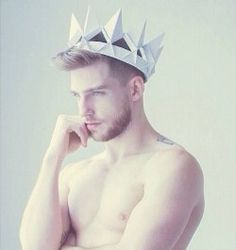
5 notes
·
View notes
Photo


ONCE ON THIS ISLAND
“Orphan of the Storm”
“Two different worlds on one island,” is a lyric heard early in Once on this Island, the Circle in the Square's sparklingly enjoyable revival of the 1990 musical by Lynn Ahrens (book and lyrics) and Stephen Flaherty (music). It’s easy to take the line as a simplistic metaphor for our current divisions: racial, sexual, economic, and political.
This mostly upbeat show, set on a Haiti-like island in the French Antilles, strongly posits love as the solution for binding disparate people together. If only.
Director Michael Arden and his top-tier team, including choreographer Camille A. Brown, set designer Dane Laffrey, costume designer Clint Ramos, lighting design partners Jules Fisher and Peggy Eisenhauer, and sound designer Peter Hylenski have put their remarkable talents together to create a kinetic, intermissionless, 90-minute production with a “devised-theatre” feeling.
Ahrens’s book—based on Rosa Guy’s 1985 novel, My Love, My Love: Or, The Peasant Girl—is largely a fable told to Little Ti Moune (Mia Williamson), a little orphan girl rescued from drowning by the gods when a horrific flood deluged the island and she was taken in by kindly villagers Tonton Julian (Phillip Boykin) and Mama Euralie (Kenita R. Miller).
You’re immersed in the dramatic world the moment you walk into the Circle in the Square’s sand-filled, theatre-in-the-oval space, packed to the brim, including laundry drying on the surrounding walls, with the effects of the recent flood; there's even an overturned boat near a watery shoreline. A goat in diapers, as well as other island fauna, are visible as the colorfully shabby peasants go about their business, sometimes even interacting with the all-too-willing audience before the show proper begins. It’s impossible, of course, not to recall the devastation of recent events in the Caribbean and elsewhere but, apart from the influence of "the gods" on human affairs, it really isn't what the show is about.
The fanciful folktale inspires imaginative images—sometimes enshrouded by Arden’s fondness for fog effects—in the costumes and props, which have an improvisatory, deceptively artless, found-object atmosphere. Watch, for example, how pieces of junk become a speeding car. Even sounds contributed, like the whooshing of swimming pool filter tubes held by actors. At one point, fans blow so strongly you can feel the storm’s winds mussing your hair (if you have any).
The story, combining elements of Romeo and Juliet and The Little Mermaid, with a touch of Euripides’ Alcestis, mingles island mythology involving four gods—Agwe (Quentin Earl Darrington), god of water; Erzulie (Lea Salonga), goddess of love; Asaka (Alex Newell), mother of Earth; and Papa Ge (Merle Dandridge), Demon of Death—with the romantic travails of the grown-up Ti Moune (Hailey Kilgore). Ti Moune, from the dark-skinned, peasant side of the island, loves Daniel Beauxhomme (Isaac Powell), from the light-skinned, wealthy, French-descended, mixed-race side, where the grande hommes live. When he’s injured in a car crash, she saves his life by offering her own to Papa Ge, who will eventually make good on their deal. The only problem: this homme’s not worth it.
The romance between Ti Moune and Daniel is blocked because of his highborn position, the objection of Daniel’s father, Armand (David Jennings), and his forthcoming arranged marriage to Andrea Deveraux (Alysha Deslorieux); Daniel, of course, is willing to keep Ti Moune as his mistress. Papa Ge cashes in when Ti Moune drowns but love (if you buy it) conquers all when she returns as a tree (crafted here to resemble a telephone cum totem pole) that happily unites everyone on the island. Well, when I think about poor Tree Moune, as I’m tempted to name her, maybe not so happily.
Regardless of the questions its plot raises, the show bursts with ebullient songs, musically underscored dialogue, colorful choreography, shadow pantomime, gorgeous costumes, and awesome lighting, not to mention exceptional performances. The exuberant ensemble is excellent, and slender Hailie Kilgore makes a fine Broadway debut as Ti Moune, both as a singer and dancer (which latter talent she displays when challenged to do so by Andrea). There’s much to love in the work of Boykin, Miller, and Powell, but it’s the four gods you’ll remember best.
Darrington is a potent, deity-like presence, his bulging muscles and shaved head (painted with blue waves) reminiscent of Dwayne (The Rock) Johnson. Newell (the transgender student, Unique Adams on TV’s “Glee”), wearing a huge skirt made from a plastic tablecloth, is every inch an earth mother; when he sings “Mama Will Provide,” you can practically feel the earth quake. Dandridge’s (TV’s “Greenleaf”) Papa Ge, looking like the lead singer in a punk rock band, has a deep voice you wouldn’t want to meet in a dark alley. And, of course, the gifted, beautiful Lea Salonga (Miss Saigon), especially in her white gown and exquisite headdress, looks the virtual embodiment of love, reminding us of why she’s a star.
So, before you take that winter trip to the Caribbean, you’d be well advised to check in for a warm-up visit to Once on this Island. You may even find that once is not enough.
Circle in the Square 1633 Broadway (at W. 50th St.), NYC
Open run
http://slleiter.blogspot.com/
1 note
·
View note